10 Hidden Gems of Rome: Off-the-Beaten-Path Experiences
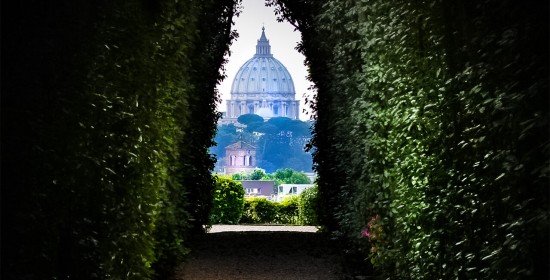
Buongiorno and welcome to Stefano Rome Tours, Rome’s premier tour company for private Rome tours and Rome Shore Excursions from Civitavecchia since 2005. The Eternal City of Rome is a destination that has charmed travelers for centuries with its iconic landmarks. While the Colosseum, the Vatican, and the Spanish Steps rightfully steal the spotlight, there are many hidden gems of Rome and off-the-beaten-path places to experience.
Join us on a journey through the "10 Hidden Gems of Rome: Off-the-Beaten-Path Experiences" as we explore some of Rome's best-kept secrets. These unique, lesser-known treasures will unveil a side of Rome few get to see, offering delightful surprises, unforgettable moments, and a profound appreciation for the city's rich history, culture, and local life. From whimsical architecture to ancient wonders, come explore the hidden gems that make Rome truly eternal.
10 Hidden Gems of Rome:
Off-the-Beaten-Path Places
1. Janiculum Hill: Rome's Hidden Panorama
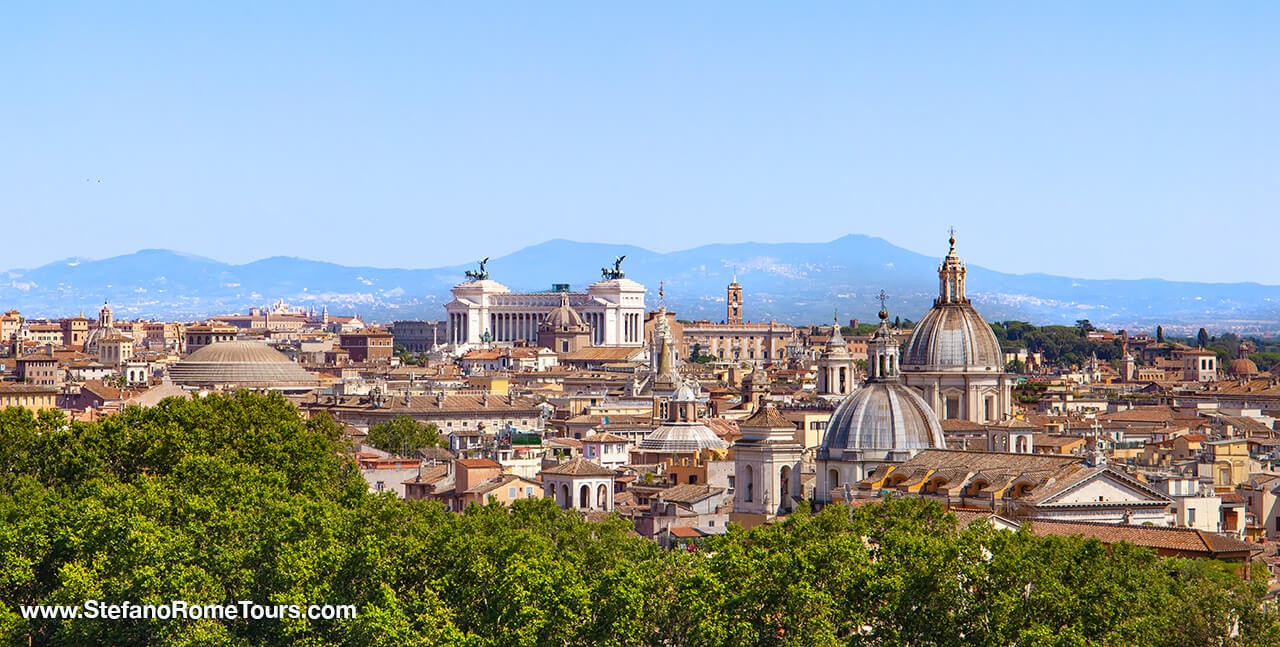
Perched high above the city, Janiculum Hill is a peaceful escape from the tourist crowds. Known in Italian as "Gianicolo", Janiculum Hill is a tranquil oasis that offers a respite from the tourist-packed historic center. This elevated vantage point is a well-kept secret, a place where both locals and savvy travelers gather to enjoy the beauty and serenity it provides. The history, the panoramic views, and the tranquil ambiance make it a must-visit destination.
The Janiculum, historically associated with the pagan god Janus, had religious significance and was integrated into ancient Rome by King Ancus Marcius to prevent enemy occupation. It played a role in the Roman-Clusium War in 508 BC. In 1849, it witnessed a significant battle between Garibaldi's forces defending the Roman Republic and French forces. The Janiculum also marks noon daily with a cannon shot, a tradition dating back to 1847 when it signaled belltowers to chime. The tradition was later moved to the Janiculum in 1904 and resumed in 1959 after a hiatus.
The hill is adorned with monuments and memorials, each telling a unique story. The monumental equestrian statue of Garibaldi, an Italian military and political hero, stands prominently as a symbol of the unification of Italy. Nearby, the Fontana dell'Acqua Paola, also known as the "Il Fontanone", is an imposing Baroque fountain that adds to the hill's charm.
- Our guests can stop to admire the view of Rome from Janiculum Hill on our POSTCARD ROME TOUR, POSTCARD ROME FOR CRUISERS, ROME PRE CRUISE TOUR, and POST-CRUISE ROME TOUR FROM CIVITAVECCHIA
2. The Aventine Keyhole: A Secret with a View
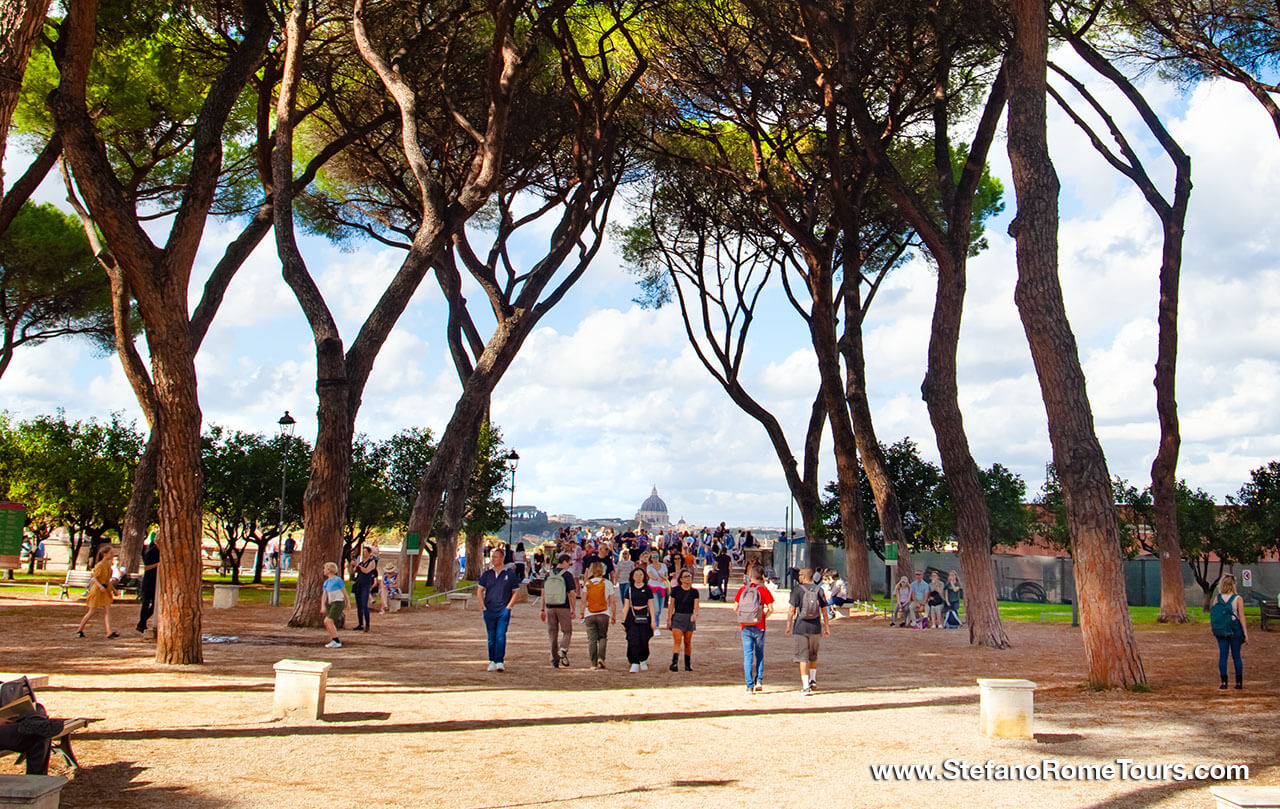
Aventine Hill, a place steeped in myth and history, has roots in Roman legend. Some believe it was named after King Aventinus, an ancient Italic ruler, while others connect it to the mythic Aventinus, son of Hercules and Rhea Silvia. The hill's significance is underscored in Virgil's Aeneid, as it's the lair of the monstrous Cacus defeated by Hercules. In Rome's founding myth, the twin brothers Romulus and Remus staged their augury contest here, ultimately leading to the founding of the city.
The Aventine Hill is also home to the Parco Savello, lovingly called the Orange Trees Garden (Giardino degli aranci). Designed in 1932 by Raffaele De Vico, this garden spans 7,800 square meters and provides an exceptional panoramic view of Rome. The name is a nod to the bitter orange trees that grace the garden. It's situated on the site of an ancient fortress built near the Basilica of Santa Sabina by the Savelli family, with roots dating back to the tenth century. Remnants of the Savelli castle's walls still enclose the garden, preserving its historical charm.
Nearby is Piazza of the Knights of Malta, a small but captivating square is best known for the unique and iconic keyhole that beckons visitors to peek through. As you approach the grand entrance of the Priory of the Knights of Malta, an ancient order with a storied history, the unassuming keyhole perfectly frames a breathtaking view. Gazing through it reveals a meticulously aligned pathway of manicured hedges leading the eye to the majestic dome of St. Peter's Basilica, creating a mesmerizing and picture-perfect composition.
The Aventine Hill, rich in history, myth, and beauty, is a place where the past and the present converge, creating a tapestry of Roman heritage and natural splendor.
3. Trastevere: Old-World Rome Nostalgia
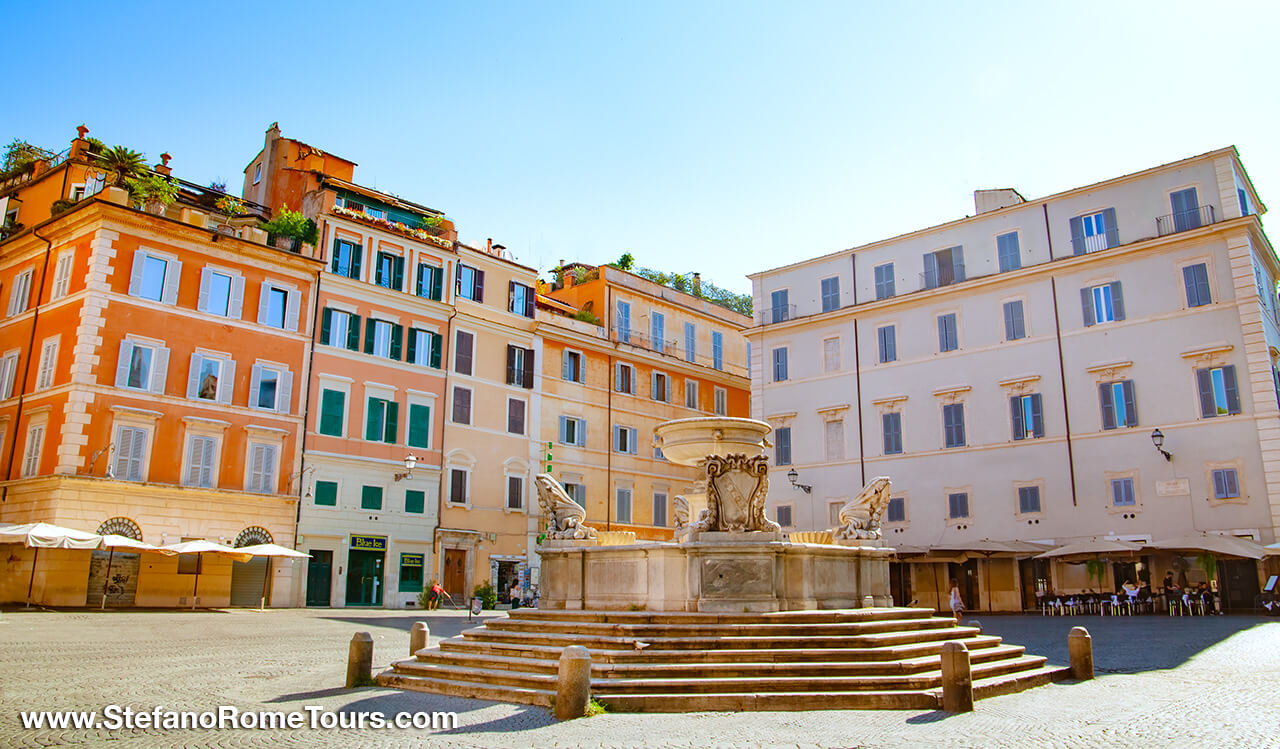
Tucked away on the picturesque west bank of the Tiber River, Trastevere is a vibrant neighborhood that encapsulates the very essence of bohemian Rome. Its very name, Trastevere, means: Across the Tiber. Its enchanting labyrinth of winding cobblestone streets, bustling piazzas, and quaint trattorias provides a unique atmosphere that feels worlds away from the usual tourist crowds. As you meander through Trastevere, immerse yourself in the world of street art, and savor the vivacious yet unspoiled tapestry of Roman life.
Trastevere is a sanctuary for those seeking an authentic and artsy side of Rome. Its eclectic and slightly unconventional ambiance attracts artists, musicians, and those who appreciate the unconventional. This neighborhood is where you can truly experience the spirit of la dolce vita, as it unfolds on the sun-soaked piazzas and in the melodies of local musicians.
While the cobbled streets and medieval buildings give Trastevere an enchanting rustic charm, there are also architectural gems like the Basilica of Santa Maria in Trastevere. This early Christian basilica, adorned with stunning mosaics, is a testament to the neighborhood's historical significance.
One of Trastevere's highlights is undoubtedly its trattorias and osterias. You can indulge in authentic Roman cuisine away from the well-trodden paths. From classic Roman dishes to inventive contemporary creations, the neighborhood offers a delightful culinary journey.
- Our guests can venture to Aventine Hill, and stroll through Trastevere on our LA DOLCE VITA ROME TOUR, ROME EXCURSION FROM CIVITAVECCHIA, and DOLCE VITA POST CRUISE TOUR FROM CIVITAVECCHIA
4. Basilica di Santa Maria del Popolo: Artistic Treasures
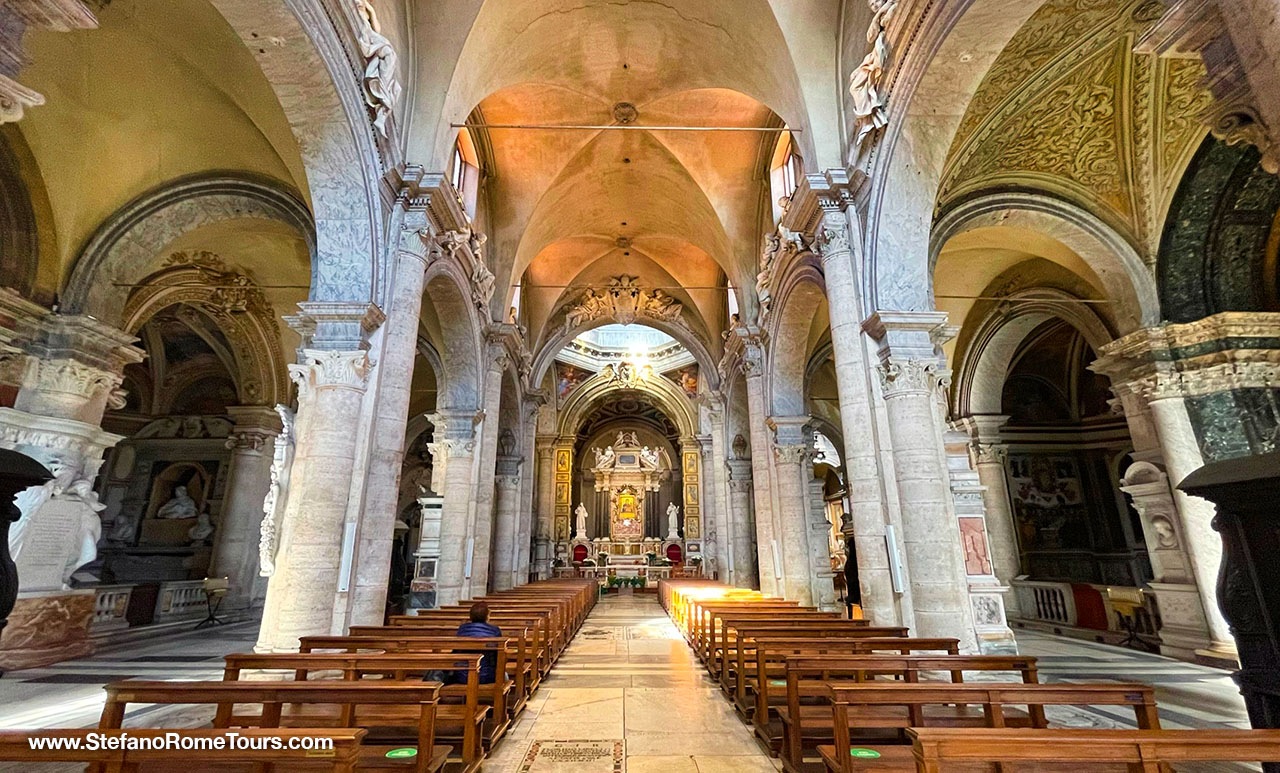
Amidst the grandeur of Rome's art scene, where visitors often flock to the Vatican Museums, an artistic treasure remains hidden within the hallowed walls of the Basilica di Santa Maria del Popolo, one of the must-visit churches in Rome. This unassuming church, graced by the genius of Caravaggio, Raphael, and Bernini, stands as a testament to Rome's artistic legacy, often bypassed by the hurried traveler. Here, art and history converge, and the absence of crowds allows you to intimately embrace the profound works it cradles.
The name "del Popolo" likely derives from "populus", signifying a vast rural parish in medieval Latin, reflecting its role as a suburban hub around Via Flaminia. Some suggest it alludes to the city's salvation from a demonic scourge or the presence of poplar trees.
In 2024, restoration has rendered the basilica closed until November 2024.
Basilica di Santa Maria del Popolo Legendary Founding:
The basilica's founding legend revolves around Emperor Nero's malevolent legacy and its cleansing by Pope Paschal II. Nero's burial in his family's mausoleum near Pincian Hill led to the emergence of a towering walnut tree, which became a gathering place for malicious demons, terrorizing locals and travelers. Concerned for the city's safety, Pope Paschal II, after three days of fasting and prayer, dreamt of the Virgin Mary, who guided him to expel the demons.
On the Thursday following the Third Sunday of Lent in 1099, Pope Paschal II led a grand procession to the infested area, where he performed an exorcism and struck the walnut tree's roots, releasing the evil spirits. With the demons banished, the site was dedicated to Christian worship.
Caravaggio's Divine Illumination:
The basilica also houses two remarkable works by the celebrated Caravaggio. His "The Conversion of Saint Paul" and "The Crucifixion of Saint Peter" masterpieces, hanging near the Cerasi Chapel, capture the divine in moments of profound human emotion. Caravaggio's mastery of chiaroscuro, the interplay of light and shadow, is on full display, allowing viewers to become one with the sacred narratives.
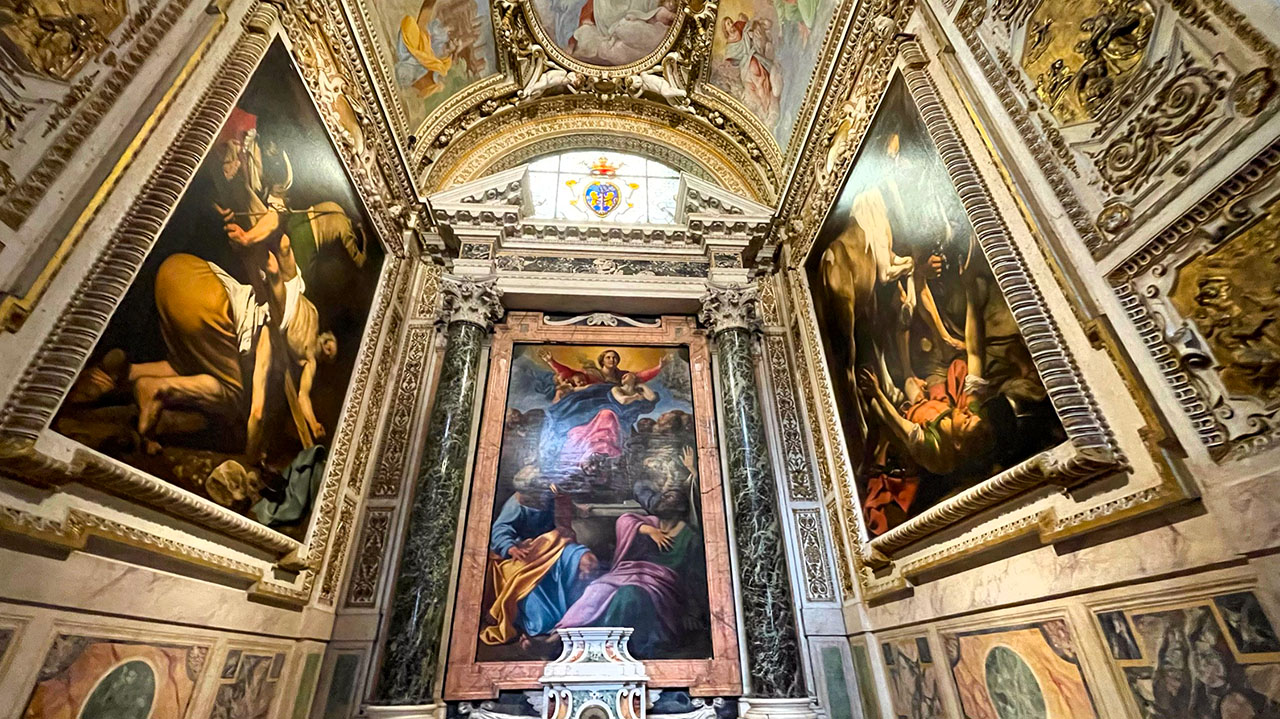
The Chigi Chapel: A Renaissance Marvel
Within Rome's Basilica di Santa Maria del Popolo, the Chigi Chapel is a testament to Italian Renaissance and Baroque art. Commissioned in 1507 by Agostino Chigi, the chapel's transformation into the Madonna of Loreto Chapel bears witness to Agostino's devout devotion.
Designed, presumably, by Raphael, the chapel's central theme revolves around the Resurrection, uniting Christian and classical motifs. With the deaths of key figures and interruptions in its construction, this masterpiece came to life gradually. The chapel, also featuring the artistry of Caravaggio and Bernini, remains an artistic treasure within the basilica, inviting exploration and reverence.
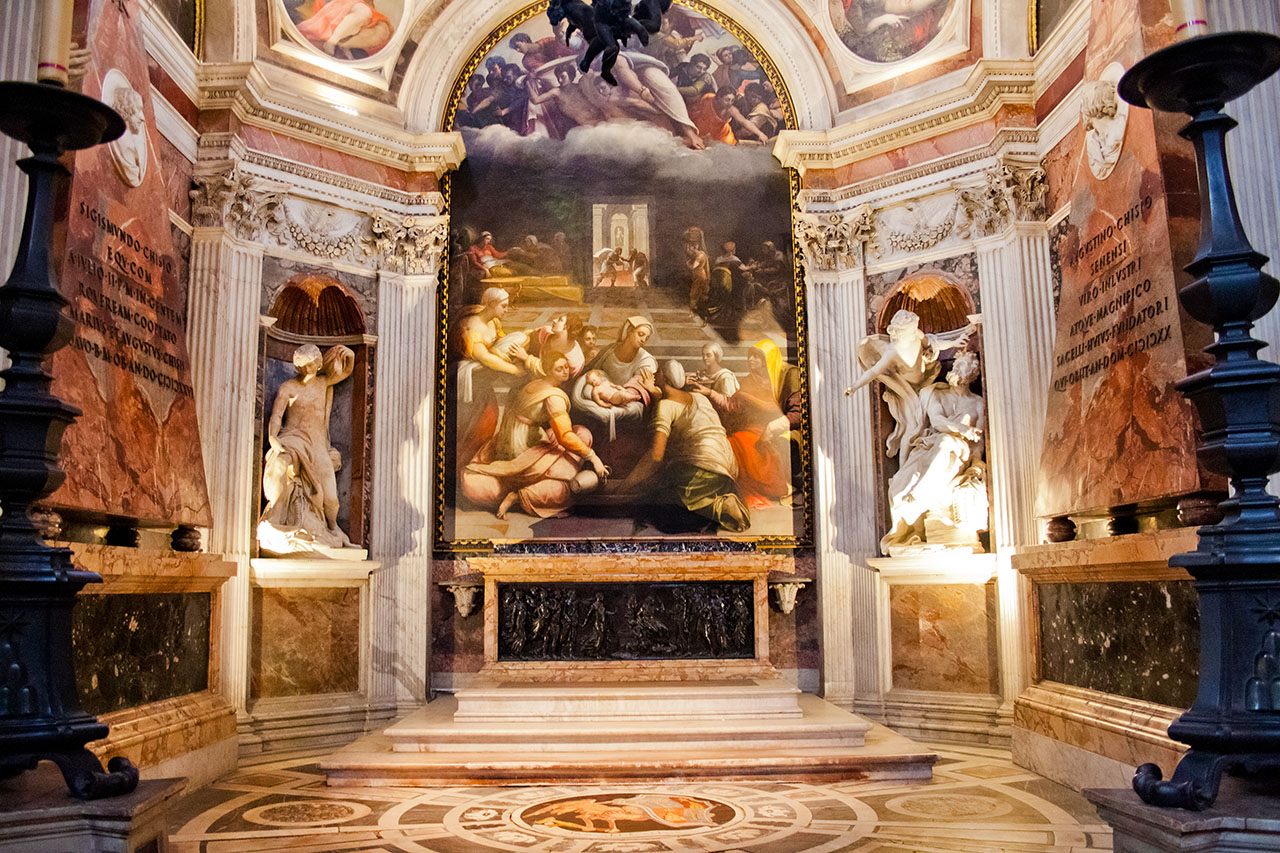
5. San Clemente Basilica: A Layered History
In the heart of Rome, the Basilica of Saint Clement (Italian: Basilica di San Clemente) stands as a testament to the city's multifaceted history. This architectural marvel is no ordinary church; it's a three-tiered time capsule that takes visitors on a journey through the ages.
At the surface, we find the present basilica, a medieval masterpiece built just before the year 1100. Beneath it lies a 4th-century basilica, originally the opulent residence of a Roman nobleman, briefly doubling as an early church in the 1st century and later as a mysterious Mithraeum in the 2nd century. But the layers continue; the nobleman's house rests upon the ruins of a Republican-era villa and warehouse, tragically consumed by the Great Fire of AD 64. As you delve deeper, each tier tells a chapter of Rome's ever-fascinating story.
Let's start by delving into the earliest layer of history, immersing ourselves in the days of the Roman Empire.
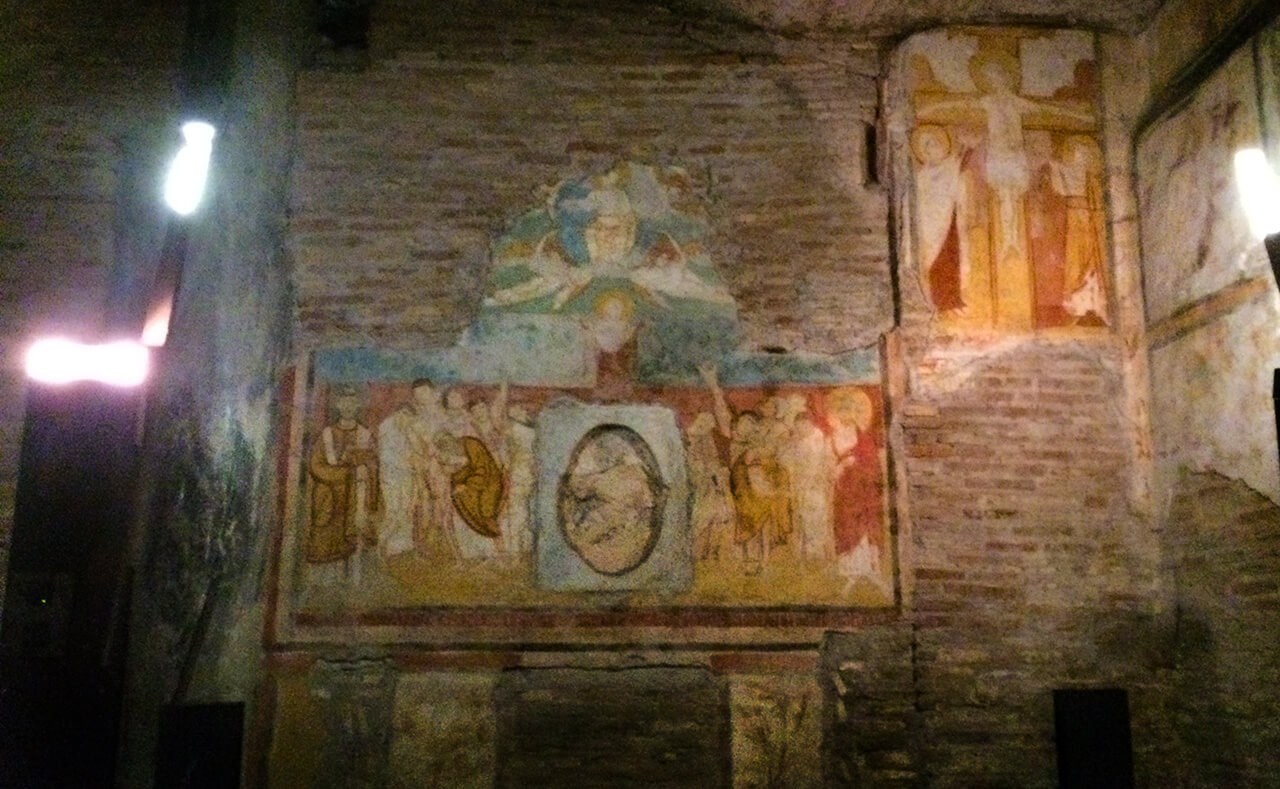
Pre-4th Century: Unearthing Rome's Early Layers
As you venture in the depths beneath the 4th-century basilica, a hidden world of Ancient Rome unfolds. Descending through an ancient staircase, you arrive at the first-century level. Here, you'll encounter the renowned 2nd-century Mithraic temple within the pre-existing "cryptoporticus" of a 1st-century Roman house, or domus. The remnants of this domus, including its stuccoed ceiling and dining area, provide glimpses into its early history.
Yet, the domus underwent a transformation. The altar, adorned with a scene of a bull's slaying and other Mithraic symbols, reflects its conversion into a center for the worship of Mithras—a faith that gained immense influence throughout Rome and the empire. This space served as a gathering point for the cult's followers.
Leaving behind the domus, you'll cross a narrow strip, stepping into a different world—a public building constructed with imposing walls of tufa stone, crowned by travertine. Inside, you'll traverse a series of interconnected rooms. This space is now believed to have been part of the first-century imperial mint, where coins and history were forged side by side.
The Hidden History of the 4th-Century Church
Ascending through a layer of history into the Middle Ages, you will enter the ancient 4th-century church. However, most of the 4th-century church's contents, including altars, marble choir, and relics, were moved to the upper church before it fell into disuse in the 12th century.
What still remains in the lower church is an array of remarkable medieval frescoes dating from the 8th to the 11th century. These frescoes offer a visual journey through the history, art, and faith of the medieval Roman Church. They include 8th-century Byzantine-style paintings, 9th-century works like the Anastasis and Ascension, and an exceptional series from the 11th century. One of these 11th-century frescoes portrays the "Legend of Sisinnius", notable for containing an early example of written Italian.
But this underground church holds yet another treasure—St. Cyril's tomb. St. Cyril, the apostle of the Slavic people, patron of Europe, and inventor of an alphabet that evolved into the Cyrillic script, has his final resting place here.
The 12th Century Basilica
Now venture further in time to the 12th century to the modern-day basilica that stands today. As you enter, you're instantly captivated by the Apse Mosaic and the intricate, Cosmatesque marble floor. The marble chancel and medieval choir bear intriguing historical significance, with the panels in the enclosure dating back to the 6th century. The upper basilica's standout feature is the 12th-century apse mosaic. The basilica also holds St. Catherine's 15th-century chapel, showcasing the dawn of the Renaissance through Masolino da Panicale's artistry.
Explore this remarkable historical layer cake to witness Rome's evolution through the ages.
6. Baths of Caracalla: Ancient Grandeur
While the Colosseum attracts throngs of visitors, the Baths of Caracalla often remain under the radar. These monumental public baths are a testament to the grandeur of ancient Rome. Explore the sprawling ruins, imagine the opulent bathing rituals, and marvel at the intricate mosaics that still grace the floors.
The Baths of Caracalla in Rome, Italy, rank as the city's second-largest Roman public baths, following the Baths of Diocletian. Likely constructed between AD 212 and 216/217, during the reigns of emperors Septimius Severus and his son Caracalla, they opened in AD 216. Nestled in the southern part of the city, these baths grew on the Horti Asiniani, a garden estate dating back to Augustus's time.
With remarkable engineering feats, the baths boasted a heating system utilizing hypocausts, which heated water from a dedicated aqueduct. These baths were both free and open to the public, attracting thousands of visitors daily, and earning a place among the seven wonders of Rome in the 5th century.
They continued to function until the 6th century when, during the Gothic War in 537, they were abandoned due to a siege by Vitiges of the Ostrogoths, leading to the city's water supply being cut off. Interestingly, a Christian pilgrimage site emerged in the mid-4th century, coexisting with the baths, bringing spiritual significance to this once opulent and thriving complex.
Wander through the extensive ruins of the baths, which provide a sense of the immense scale and grandeur of the complex. The well-preserved walls, vaulted ceilings, and structural remains give you an idea of what this place was like in its prime.
While many of the finer decorations have been moved to museums, you can still see some of the original mosaics and frescoes that adorned the baths. These provide insight into the art and aesthetics of the time.
Remember to wear comfortable shoes and bring water, especially during the hot summer months, as there is a lot of walking to do. The Baths of Caracalla provide a fascinating glimpse into the daily life of ancient Romans and their architectural and engineering prowess.
7. Appian Way: The Queen of Roads
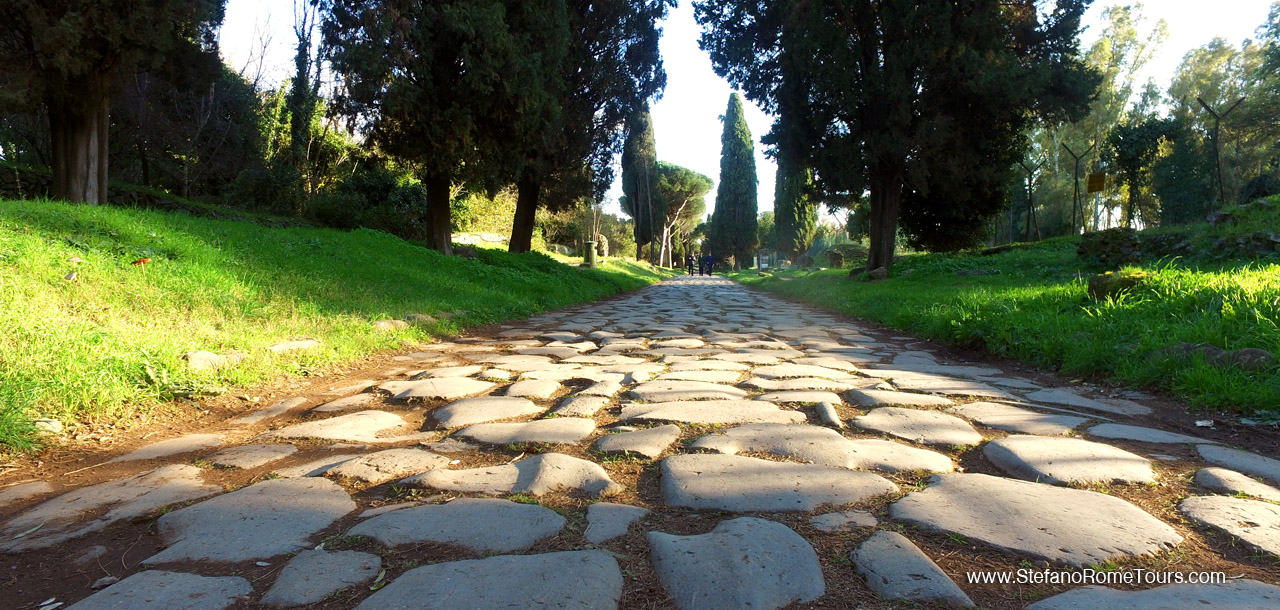
Step off the well-trodden path and onto the ancient Appian Way, often referred to as the "Queen of Roads" and considered one of the most famous ancient Roman Empire Roads. Stretching over 350 miles, this remarkable thoroughfare is an emblem of Italy's rich history. Built around 312 BC, it was a masterpiece of Roman engineering, connecting Rome to the southern regions of the Italian peninsula. As you wander along its original cobblestones, you'll find yourself on a 2,300-year-old journey, following in the footsteps of ancient Romans.
One of the Appian Way's most significant attributes is its cultural and historical value. It is dotted with a plethora of fascinating sights, each revealing a layer of Rome's vibrant past. Among the notable attractions are the Catacombs of San Callisto, which are subterranean burial chambers that housed the remains of thousands of early Christians. These catacombs are a remarkable testament to the religious and spiritual history of Rome.
As you stroll along this ancient road, you'll also come across an array of ancient tombs and ruins that echo with tales of long-forgotten individuals and events. These remnants of the past allow you to feel intimately connected with the history of Rome.
Here are a few notable ones you might encounter:
Cecilia Metella Mausoleum: This cylindrical mausoleum is one of the most iconic landmarks along the Appian Way. It was built for Cecilia Metella, a Roman noblewoman. The mausoleum's imposing presence and well-preserved state make it a striking sight.
Villa of the Quintilii: These are the extensive ruins of a luxurious villa that once belonged to the wealthy Quintilii brothers. The complex includes bathhouses, living quarters, and beautiful gardens.
Circus Maxentius (Circo di Massenzio): This well-preserved circus was built by the Roman Emperor Maxentius, who ruled in the early 4th century. It's a prime example of Roman engineering and grandeur.
Each crumbling stone and partially preserved structure holds the potential to transport you to a bygone era, allowing you to feel an intimate connection with the history of Rome. The Appian Way serves as a living museum, where the past continues to resonate with the present, inviting you to explore the layers of history that have shaped this magnificent city.
8. Roman Houses on Celian Hill (Case Romane nel Celio)
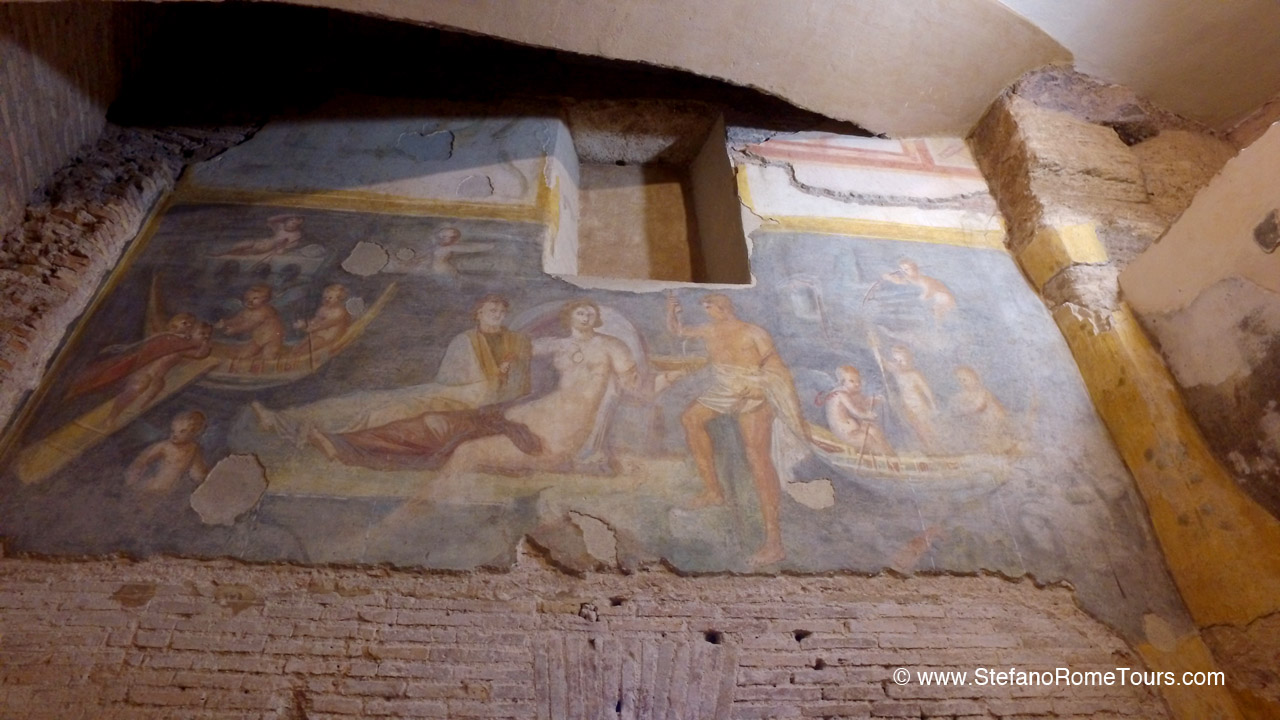
Beneath the city's surface, a hidden world of Roman history is waiting to be explored. The Roman Houses on the Celian Hill, also known as Case Romane nel Celio, offer a subterranean adventure into well-preserved ancient Roman homes and their intricate frescoes. This underground tour reveals the daily lives of Romans and provides an intimate look at the city's past.
The four phases of the history of Roman Houses on Celian Hill:
The Domus: In the early 2nd century, a luxurious two-story residential building, complete with a spa on the ground floor and living spaces on the upper floor, occupied the area where the present basilica stands.
The Insula: Around the early 3rd century, an insula was constructed in front of the domus. This multi-story building featured rented apartments and commercial spaces on the ground floor, catering to the lower-class affluent residents.
The New Domus: Transitioning into the late 3rd and early 4th century, a single owner acquired the entire block. While the upper floors likely remained divided into rental apartments, the ground floor was transformed into a noble residence for the owning family.
The Domus of the Martyrs: In the latter half of the 4th century, Christian tradition associates this site with Saints John and Paul's residence. The construction of the basilica, initiated in the early 5th century by Senator Pammachio, who was likely the last owner, led to the removal of the Roman structures.
This basilica's foundations cut through the rooms below, leaving most of the area unused. In the 19th century, extensive frescoes were discovered beneath the basilica's chancel, leading to significant excavations and restorations. The site was opened to the public in 2002, offering a captivating journey through centuries of history and purpose, including medieval oratories and layered Roman houses.
Must-see chambers of Roman Houses
Genius Hall: Originally a warehouse turned elegant reception room in the 3rd century, featuring marble opus sectile decorations with winged figures in the lower register and a harvest scene above.
Faux Marble Hall: Named for frescoes from the early 4th century, mimicking a marble covering with acanthus scrolls and birds in the lower register. The upper register's naturalistic frescoes are mostly lost.
Prayer Hall: Dating to the early 4th century, it boasts wall decorations with a plinth imitating marble opus sectile, floral patterns, and a well-preserved figure of a praying woman.
The Confession: A small place of worship from the mid-4th century, linked to the martyrdom of Saints John and Paul. A late 4th-century niche displays scenes of Christian martyrs and adoring figures.
Nymphaeum: Three walls depict a mythological marine scene. Two female figures stand on an islet with a male figure pouring a drink.
Antiquarium: Housed in the Chapel of San Paolo della Croce, this small museum contains Roman and medieval artifacts from 19th- and 20th-century excavations, including alabaster busts, glazed ceramic plates, and a 12th-century fresco.
OPENING DAYS/ TIMES:
Monday, Wednesday, Friday, Saturday, Sunday and holidays
10.00-16.00
Closed on
Tuesdays and Thursdays other than public holidays, January 1st, December 25th
9. Quartiere Coppede: Architectural Marvel
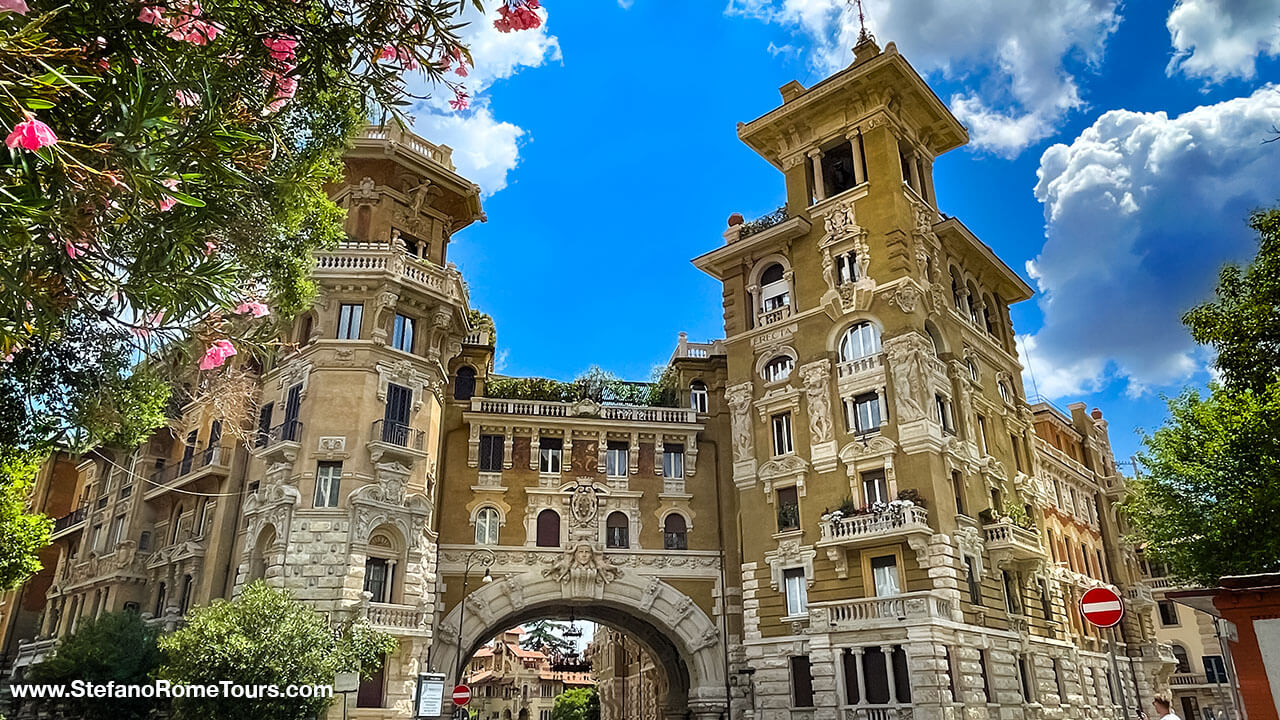
Experience the whimsical Quartiere Coppede, a hidden gem boasting extraordinary architecture. Tucked away in Rome's Trieste neighborhood just off of Piazza Argentina, it's a short trip from the city center.
As you explore, you'll find a captivating blend of fantastical architectural styles, from Gothic to Art Nouveau. Each building is a masterpiece, featuring intricate facades, vibrant mosaics, and ornate gates, defying traditional norms to create a visual spectacle.
Architect Gino Coppedè's 20th-century vision drew inspiration from various sources, resulting in a truly unique neighborhood. Quartiere Coppede showcases wonders like the "Fountain of Frogs", "House of the Sirens", and "Arch of the Masons". Every corner tells a story, each detail whispers secrets, and Coppedè's imagination shines.
This neighborhood stands as a living work of art, where creativity knows no bounds. It's where history meets the fantastical, and every step through its winding streets reveals the boundless possibilities of human imagination. Visit Quartiere Coppede for a journey into a one-of-a-kind architectural marvel that celebrates its creator's vivid dreams.
10. Basilica of Saint Mary of the Angels and Martyrs
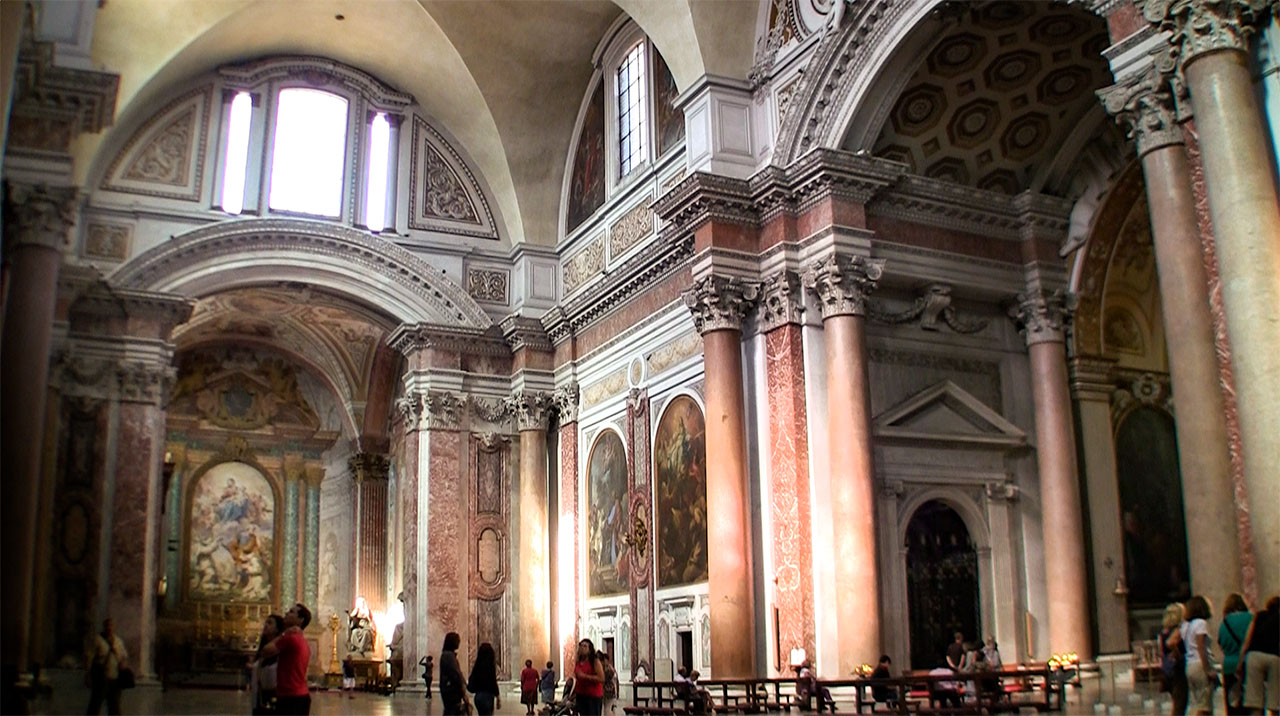
Tucked within the grandeur of the Baths of Diocletian in Rome's Piazza della Repubblica is a well-kept secret – the Basilica of St. Mary of the Angels and Martyrs. This basilica, dedicated to both known and unknown Christian martyrs, is a true marvel, combining a rich history with remarkable architecture.
In the 16th century, the famous Michelangelo Buonarroti set the foundation with his original design. Yet, it's not just his influence that shines here; subsequent generations of architects and artists added their unique touches to this extraordinary place.
The Mystical Vision that inspired the Basilica
In 1561, Pope Pius IV, moved by a mystical vision and inspired by the persistence of a Sicilian monk named Antonio del Duca, issued a decree to build this church. Its full title became the "Beatissimae Virginis et omnium Angelorum et Martyrum", honoring the Most Blessed Virgin and all Angels and Martyrs. The church is also a personal monument to Pope Pius IV, with his tomb resting in the apsidal tribune.
Michelangelo's work transformed a portion of the Baths of Diocletian into an exceptional church, and his apprentice, Jacopo Del Duca, carried the torch after Michelangelo's passing. Luigi Vanvitelli lent his hand to the construction in 1749, but in 1911, a part of the church's façade was removed to reveal the intriguing niche of the caldarium, showcasing ancient Roman bricks.
Inside, St. Mary of the Angels surprises with its unique architectural layout. The church boasts a Greek cross design with a prominent transept and cubical chapels at each end, creating captivating spaces. The entrance is simple yet distinctive, preserving the concave brick shape from the ancient exedras of the caldarium.
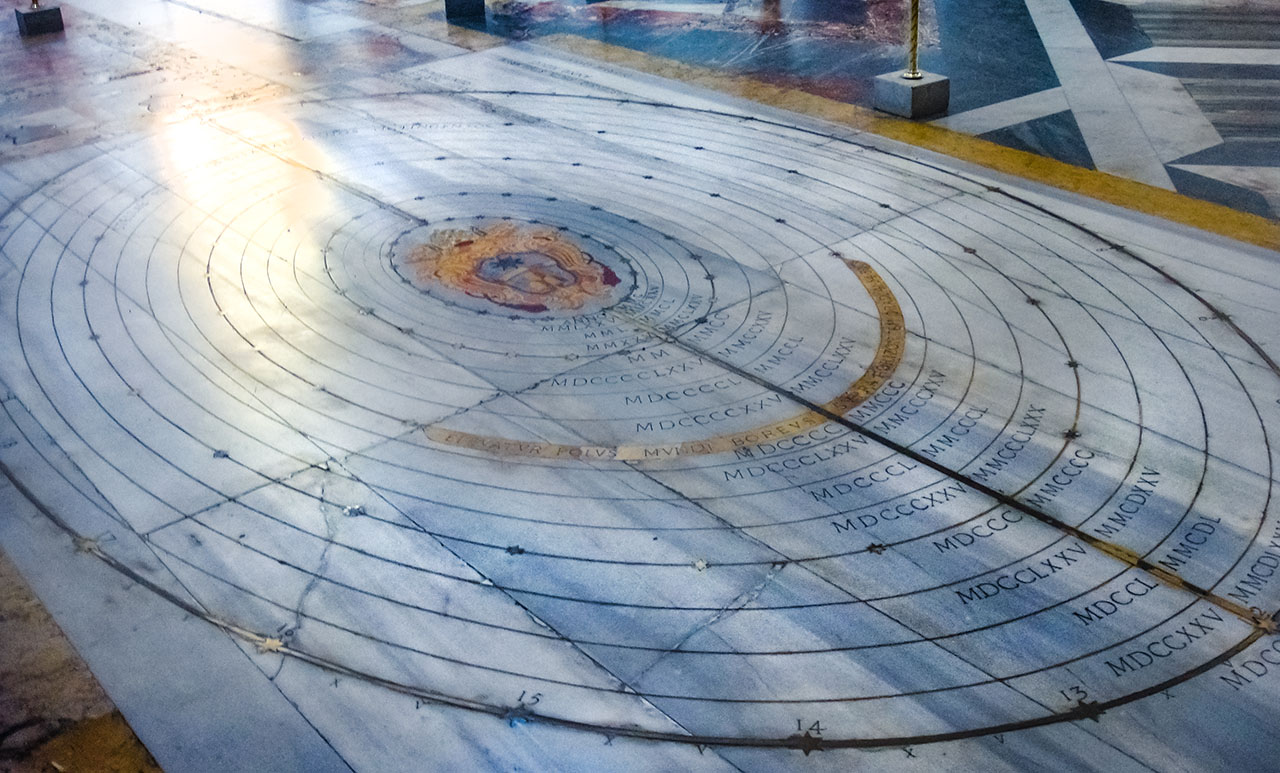
The Meridian:
One of the most fascinating features of the basilica is the meridian line constructed in the early 18th century, commissioned by Pope Clement XI. This sundial, designed by Francesco Bianchini, served a triple purpose: verifying the accuracy of the Gregorian calendar reform, precisely predicting Easter, and providing Rome with a meridian line as notable as the one in Bologna's Basilica of San Petronio.
The Basilica of St. Mary of the Angels and Martyrs beckons as a hidden treasure, tucked away in Rome's rich history. With its storied past, architectural grandeur, and an enigmatic meridian line, it stands as a testament to Rome's eternal allure.
These off-the-beaten-path experiences not only help you avoid the crowds but also offer a deeper and more authentic perspective on Rome. As you explore these hidden gems, you'll find yourself enchanted by the city's rich history, culture, and local life. Rome's secrets are waiting to be unveiled, promising delightful surprises and unforgettable moments for those who seek them.
Thank you for reading our travel blog and for choosing Stefano Rome Tours for your private tours in Italy!
